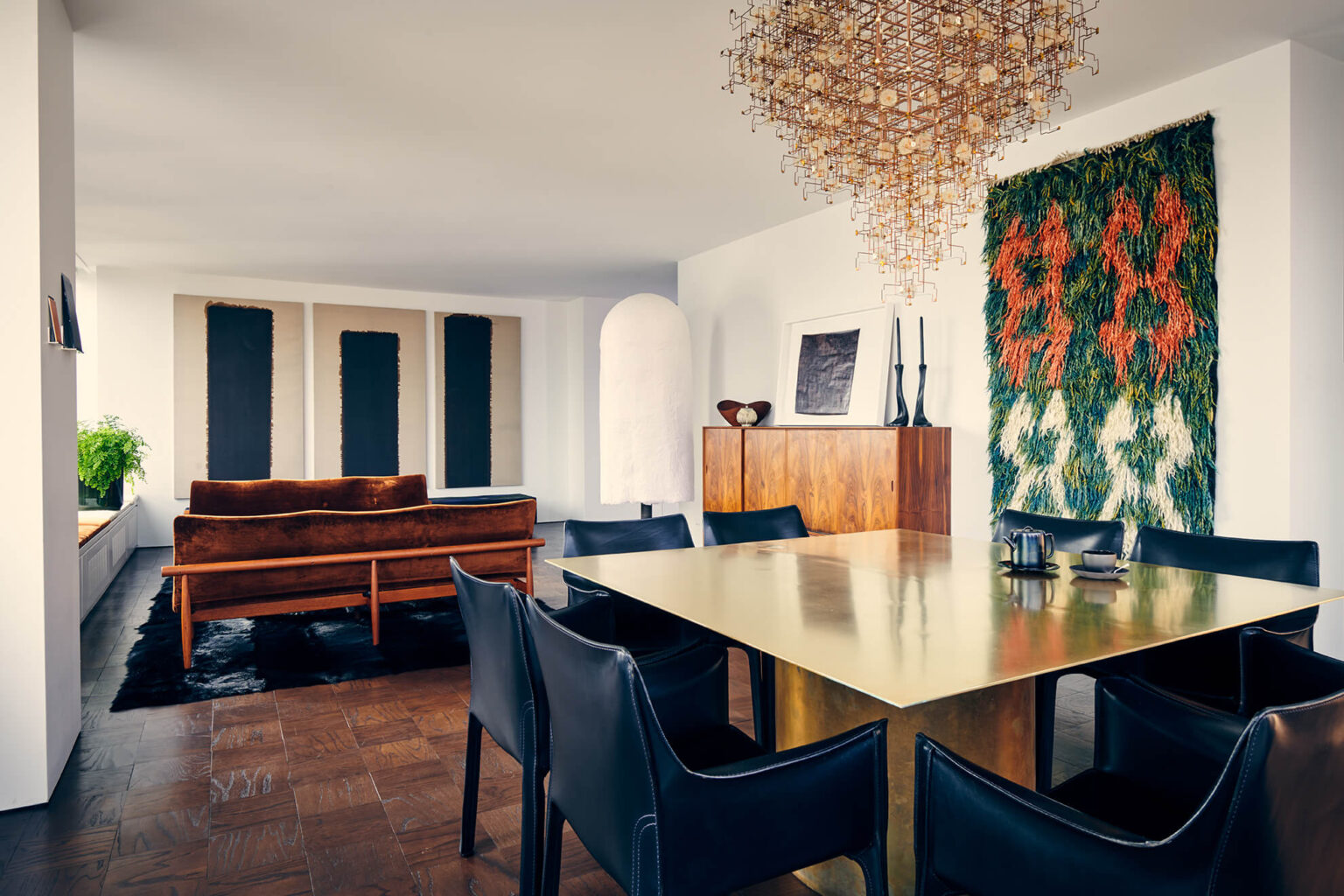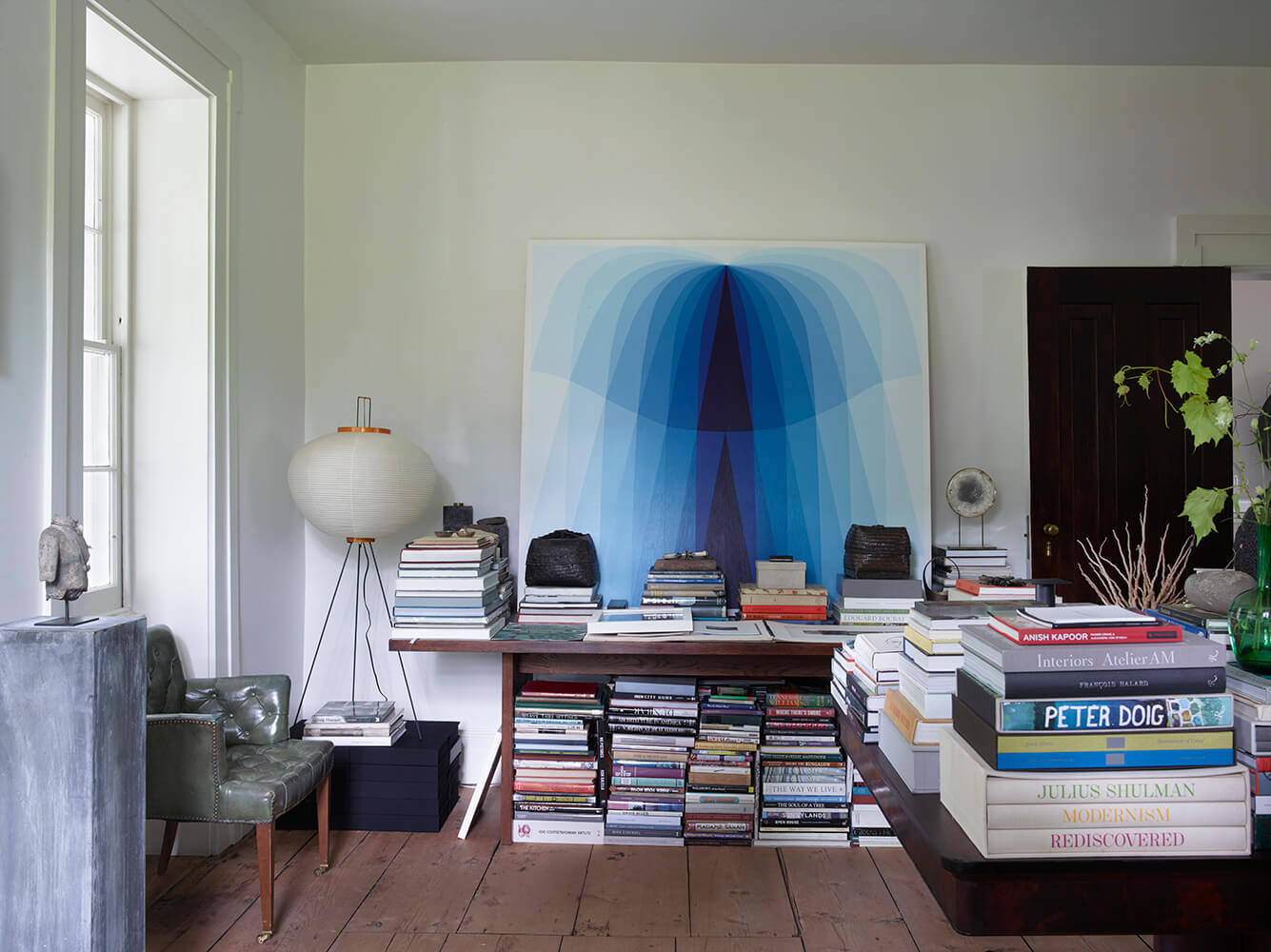
In the late summer of 2022, we were in the final phase of work on a glamorous 29th floor pied-à-terre in Tribeca. We were installing the last pieces of furniture and furnishings, getting the apartment ready for the clients who would be arriving the next month for an autumn in New York. Inside the color-blocked bedrooms, beds were made, pillows were fluffed, lamps were centered on end tables. In the bathrooms, towels were folded and stacked, in the hallways and under furniture, rugs were rolled out. In the white-walled main space with sweeping city views visible out the windows, chairs were arranged at the dining room table, and nearby, the living room was beginning to come to life. A braided sofa upholstered in iridescent blue-purple velvet took center stage with a sculptural standing lamp by its side and an abstract mosaic tile coffee table in front. At the end of the installation, this room, and this elevation in particular, was an obvious focal point, except for one thing. The wall above the sofa was completely blank.
One of the most interesting phases of any interiors project is the layering-in of art, which can include anything from painting and works on paper to photography and sculpture. And because it is such an important element in the planning of a space, art is something we think about from the very start of a project. A client might be well-versed in the subject and already have an established art collection, or they might be new to the art world and new to collecting. In the case of the former, we will review the collection to familiarize ourselves with the client’s aesthetic and what gaps they are looking to fill—in other words, what additional pieces, if any, they are looking to obtain. In the case of the latter, we are more or less starting with a blank slate. Whether we are consulting on which works within an existing collection look best in which room or on which wall, or guiding someone in the sourcing and buying of new work, it is our job to determine which pieces will enhance a space aesthetically.
And in this job, as with all other facets of a project, it’s of utmost importance that we listen and try to empathetically understand the client’s sensibility. In our experience, some clients have a heightened engagement in the selection of art, because it is extremely personal, and it has the ability to become a symbolic representation of who they are and how they want to be perceived publicly.
How we go about looking for art usually depends on the scenario—on the client’s familiarity with it and on their goals. If we are working with someone who already owns art and is seeking additional pieces, we usually start by reaching out to galleries or to artists directly, whose work, or the work they represent, we think will complement the current collection. When working with a client who is new to the art world and collecting, we typically begin by taking them to art shows like Frieze or Art Basel or to visit auctions at Phillips or Christie’s. This exercise helps us gain an understanding of the types of art the client likes (or doesn’t like!) and is a good way for us to introduce them to the costs they can expect when purchasing art. We use whatever feedback we receive after these visits as a basis for follow-up presentations in which we try to build a vocabulary of other works we feel the client may gravitate towards and best fit within their budget. It’s rare that art for a project ever falls into place immediately. What’s more common is that the effort might include several rounds of sourcing and presenting until the client feels that a piece or pieces are right.
Regardless of whether we are guiding someone on starting a new collection or adding to an existing one, clients usually have at least some idea of what they like in terms of colors, themes, or genres. We try to never choose are by color, but a client may prefer warm hues over cool hues, or request us to stay away from a certain palette. Over the years, we have had clients primarily interested in work by artists of a certain cultural background or in work that focuses on a particular social cause or with a subject matter or emotions that align with their own. Understanding such specifics not only adds an interesting facet to our search, but also helps us to narrow it, and often informs which galleries we reach out to. From time to time, we work with art consultants whose in-depth knowledge of the field is an extremely valuable asset and helps us streamline our process. We are fortunate to have cultivated close relationships with a number of them over the years. When it came time to begin researching art for an upper west side apartment project whose clients had a specific interest in black-and-white work and upwards of a dozen walls to fill, we enlisted the help of Tanja Grunert of Tanja Grunert Gallery. For a project on the upper west side at which the client was looking for works that evoked feelings of nature and storytelling, we reached out to Marisa Newman of Marisa Newman Projects. She helped select the perfect piece by Helen Beckman for a prominent wall in the client’s entryway.
Arriving at the selection of art that a client wants to purchase is progress, but even at this point, there are still several steps in the process. Many of the galleries from which we source art are located in New York, but it isn’t unheard of that it’s coming from a gallery in another state, or abroad. This means we need to coordinate shipping, and more often than not—considering the value and fragility of a work—crating. Factoring in packing and transit time, it could be anywhere from a few days to several weeks for a piece to land at a project. But of course, beyond getting to the building, the art needs to get into the residence. It isn’t a common occurrence, but we have run into the issue several times in the past, where the artwork was too large to fit into the elevator and the only solution was to hoist it into the apartment through a window. This means added time and coordination and expense.
As for the Tribeca pied-à terre… While not yet seasoned collectors, our clients, a husband-and-wife creative team, were very eager to embark on a journey into the art world. It was apparent to us from our first meeting with them that they possessed a keen interest in art and design. So, after assessing their goals, we decided to start our search with a visit to The Salon Art + Design Fair. The annual show, which takes place at the Park Avenue Armory, includes galleries from around the world showcasing antique and modern furniture and objects as well as contemporary art. Walking with our clients through the immense space, we were able to get a feel for what they liked. They shied away from anything too expected and instead were excited by the unusual, looking for dynamic pieces to fill their apartment. They gravitated towards pieces by Michaelangelo Pistoletto and Anthony James which worked well in a number of the color-blocked private areas within the space but weren’t quite right for that important focal point—the blank white living room wall.
Over the next few months, we exchanged numerous emails with the clients, discussing the merits of the many options in front of us. And then one day, while shopping on 10th Street, David happened across a set of four ceramic wall sculptures that were being unpacked from a crate at one of our favorite galleries Maison Gerard. The pieces, on which delicate formations of flowers, fauna, birds, and snakes are finished in a matte black glaze, were an enigmatic wonder. He knew right away that these would be perfect for the apartment and perfect for the blank wall. He just wasn’t sure about keeping it white. So he pitched an idea to the clients: How about painting it matte black? Without hesitation, they said they were up for the bold idea. Three days later, the wall was black, and the pieces were installed. Our search was finally over, and what had been a challenging aspect of the project now anchored the concept of the entire apartment. What was once an incomplete space now made perfect sense—so much so, that shortly thereafter we shot the apartment for publication in a magazine. Coming soon…




